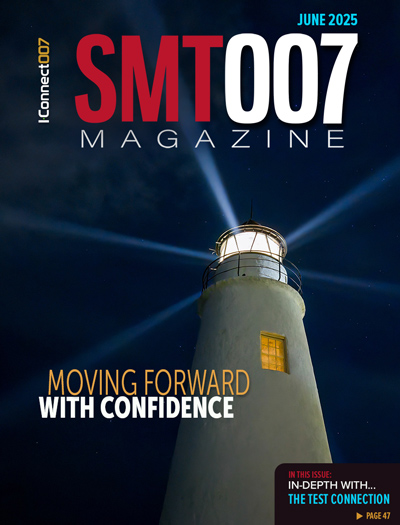-

- News
- Books
Featured Books
- smt007 Magazine
Latest Issues
Current Issue
Supply Chain Strategies
A successful brand is built on strong customer relationships—anchored by a well-orchestrated supply chain at its core. This month, we look at how managing your supply chain directly influences customer perception.

What's Your Sweet Spot?
Are you in a niche that’s growing or shrinking? Is it time to reassess and refocus? We spotlight companies thriving by redefining or reinforcing their niche. What are their insights?

Moving Forward With Confidence
In this issue, we focus on sales and quoting, workforce training, new IPC leadership in the U.S. and Canada, the effects of tariffs, CFX standards, and much more—all designed to provide perspective as you move through the cloud bank of today's shifting economic market.
- Articles
- Columns
- Links
- Media kit
||| MENU - smt007 Magazine
Estimated reading time: 3 minutes
Powerful Prototypes: A Trip Back to the Basics
Ever have one of those moments when you realize that you’ve been distracted from a core competency of yours for a while and dealing with another big project or a crisis of some sort (such as a global pandemic), and you get the feeling that you have lost a bit of your edge? I am kind of feeling that right now.
While my day job is marketing, after hours, I design and build electronics projects. Sometimes, I do the assembly myself for the challenge. Other times, I let the experts in my factory do the assembly to make sure it gets done correctly. Regardless, I’m feeling a bit out of touch these days. The last thing I designed was the pre-COVID-19 “You Do You” motion-sensitive lapel pin for the 2020 Open Source Hardware Summit; I’ve written about this project in a previous column (Figure 1).
Figure 1: Both PCBs, sitting on my keyboard.
Unfortunately, the conference, which was supposed to take place on March 13, 2020, was canceled due to the COVID-19 outbreak. The lapel pins had already been delivered to the conference venue. I’m not sure if they are still there, or if they have been picked by the OSHW folks, but that’s neither here nor there. What is here and there is that there are more lessons to learn and more fundamentals to review from this project.
The first thing that jumped out at me came from the blank prototype version of the board I had sitting on my desk. Both the prototype (the green board with no parts on it) and the final production boards (in blue) have an immersion silver PCB finish. Immersion silver is great for small parts. The surface is very flat. Hot air surface leveling (abbreviated as HASL or HAL) is usually the same price or sometimes even less expensive and comes in both leaded and lead-free. It’s still a popular choice, especially if you prefer the leaded surface. However, it has an uneven surface. An uneven surface is fine for big parts but can lead to a lot of difficulties when assembling fine and ultra-fine-pitch parts.
Electroless nickel immersion gold (ENIG) is also a great surface finish, but it’s more expensive than immersion silver. If you have the extra budget, ENIG is a great way to go. It has the same flat surface, great solderability, and better environmental tolerances.
Any board surface will go bad if mistreated enough, but silver tends to be more sensitive to the environment. It can more easily suffer corrosion and is somewhat light sensitive. It also is more prone to damage from finger oils. Figure 2 shows the footprint for my microcontroller. It’s PIC18F46K22 in a 40-pin, 5 mm x 5 mm quad flatpack no leads (QFN) package.
Figure 2: Damage to QFN footprint due to improper storage and handling.
I have had this blank PCB sitting on my desk, exposed to light, air, fingerprints—everything—since it was fabricated in February of this year. It’s not anyone’s fault; it’s just the way silver reacts to the environment. It speaks to the need for careful handling and storage or prompt use of immersion sliver PCBs. Use them within a few weeks of fabrication or store them in a cool, dark place. Keep them sealed in the original packaging from the fab shop if you can, and then you will have a lot more time flexibility in when to use the boards.
Here are three tips for determining what surface finish to use:
- When you have large parts, hand soldering, a lot of through-holes, and need good surface longevity and a low price, HASL is a fine choice.
- When you have a flat surface for small parts; need the same price as HASL, RoHS compatibility, and the best machine assembly; and can use the boards within a month or so and/or can store them away from bright lights and polluted air, immersion silver is a great choice.
- When you have a flat surface for small parts and need RoHS compatibility and the best environmental stability and machine assembly, and can handle a higher price, ENIG is your best bet.
There are always exceptions to every rule, so let your application and any specific requirement you might have be your final guide; however, the aforementioned three points can get you started in the right direction.
Duane Benson is marketing manager and CTO at Screaming Circuits.
More Columns from Powerful Prototypes
Powerful Prototypes: Small Computer ModulesPowerful Prototypes: The Work World in 2021
Powerful Prototypes: Why Datasheets Matter
Powerful Prototypes: Manufacturing in an Uncertain World
Powerful Prototypes: An Open-Source Adventure
Powerful Prototypes: Five Technological Shifts in the New Decade
Powerful Prototypes: Cost Reduction in Design
Powerful Prototypes: New PCB Fab Technology—What You Need to Know


